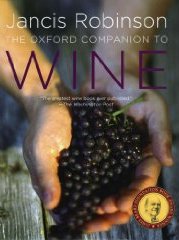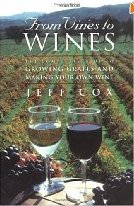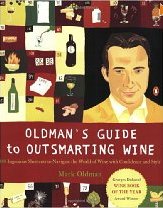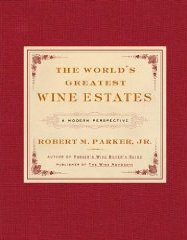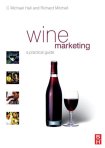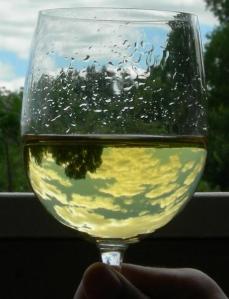On Wednesday I visited Château Haut-Brion and met with Turid Hoel Alcaras, the estate’s PR manager. Haut-Brion is located in the Pessac Léognan AOC and is one of the original four First Growths from the 1855 Classification. Additionally the estate is a Cru Classé from the 1959 Graves Classification, which makes Haut-Brion the only First Growth estate located outside of the Medoc.

The estate manages 48 hectares of red grape vines and 2.7 hectares of white grape vines. The average age of the vines is 38 years and the average yields are 45 to 55 hectoliters per hectare. The breakdown of red grapes is 45% Cabernet Sauvignon, 45% Merlot, and 10% Cabernet Franc. For the whites, the composition is 55% Semillon and 45% Sauvignon Blanc. The soil consists of gravel and sand with large stones, reaching 12 centimeters in diameter. The clay subsoil provides for a nice balance, especially during dry seasons, since the clay helps to preserve the moisture. Due to the terroir and in particular the South-of-Medoc orientation, Haut-Brion’s harvest is always 1 to 2 weeks earlier than in the Medoc.

The red wine vinification at Haut-Brion is very high-tech and unique. The estate manages a large laboratory and conducts all of its own analyses. In fact since 1970 Haut-Brion has conducted its own clone research, analyzing over 100 different clones and 1,600 different parameters. The enologists discovered that at Haut-Brion 10% of the clones were well adapted to the terroir, 10% were inadaptable, and the remaining 80% were dependent on the conditions of the climate. This study permitted Haut-Brion to make key decisions on clone selection and plantings and overall vineyard management.
 Once in the winery, the fermentation and maceration lasts for 2 to 3 weeks, followed by the malolactic fermentation in the vat. So why high tech and why unique? Well first regarding the temperature control and extraction systems, the process is completely computerized. Pump overs are conducted automatically vat by vat. Furthermore, the temperature is controlled 60% through pump overs, since the juice at the bottom of the vat is cooler than cap. The remaining 40% of the temperature management is controlled with water pumps. This practice reduces the temperature variation and fluctuation throughout the vat, which helps maintain the quality of the wine. What is really impressive; however, are the stainless steel vats, which were designed by the Haut-Brion team. Each vat is divided into a completely separate top and bottom compartment. The top compartment is where the fermentation and maceration takes place. The bottom compartment is reserved for the malolactic fermentation. It is two-thirds the size of the top compartment, since one-third of the space in the top compartment is taken up by the cap or the solids. This point is important because as a result the bottom compartment is completely filled with wine from the top compartment, without any need to top up with wine from another vat. Thus the consistency is maintained within each vat. The final interesting point is that the division between the two compartments is slanted at about 30 degrees. This permits an easy removal of the cap without requiring workers to enter the vat, which poses health risks and a threat of CO2 suffocation. Once the malolactic is completed the final blend is made and the wine is transferred to 70 to 90% new oak barrels where aging will proceed in the traditional method for 18 months. An interesting note of reference at this point is that Haut-Brion leases space to a cooperage on site. 80% of the oak barrels come from this source, Seguin Moreau, which allows Haut-Brion to control the toasting, preferring a medium toast that is not too strong.
Once in the winery, the fermentation and maceration lasts for 2 to 3 weeks, followed by the malolactic fermentation in the vat. So why high tech and why unique? Well first regarding the temperature control and extraction systems, the process is completely computerized. Pump overs are conducted automatically vat by vat. Furthermore, the temperature is controlled 60% through pump overs, since the juice at the bottom of the vat is cooler than cap. The remaining 40% of the temperature management is controlled with water pumps. This practice reduces the temperature variation and fluctuation throughout the vat, which helps maintain the quality of the wine. What is really impressive; however, are the stainless steel vats, which were designed by the Haut-Brion team. Each vat is divided into a completely separate top and bottom compartment. The top compartment is where the fermentation and maceration takes place. The bottom compartment is reserved for the malolactic fermentation. It is two-thirds the size of the top compartment, since one-third of the space in the top compartment is taken up by the cap or the solids. This point is important because as a result the bottom compartment is completely filled with wine from the top compartment, without any need to top up with wine from another vat. Thus the consistency is maintained within each vat. The final interesting point is that the division between the two compartments is slanted at about 30 degrees. This permits an easy removal of the cap without requiring workers to enter the vat, which poses health risks and a threat of CO2 suffocation. Once the malolactic is completed the final blend is made and the wine is transferred to 70 to 90% new oak barrels where aging will proceed in the traditional method for 18 months. An interesting note of reference at this point is that Haut-Brion leases space to a cooperage on site. 80% of the oak barrels come from this source, Seguin Moreau, which allows Haut-Brion to control the toasting, preferring a medium toast that is not too strong.
The history of Château Haut-Brion spans five centuries. In 1525 Jean de Pontac, a civil and criminal registrar with the Parliament of Bordeaux, married Jeanne de Bellon and received the estate as a dowry. Pontac designed and built the château. One of his heirs (he fathered 15 children between 3 wives), Arnaud de Pontac, continued to grow the estate’s eminence after Jean’s death at the age of 101. Arnaud was an expert wine maker and in 1660 he was the first to begin the systematic process of topping up and racking the barrels. By the end of the 17th century Haut-Brion’s reputation was spread all throughout Europe. And in 1787 Thomas Jefferson visited the estate, writing back to a friend in Virginia, “I cannot deny myself the pleasure of asking you to participate in a parcel of wine. It is the vineyard ‘Obrion’, one of the four established as the very best, and it is the vintage 1784. Six dozen bottles will be packed and separately sent to you.” Jefferson later wrote to an American consul in Bordeaux, “Haut-Brion is a wine of the first rank and seems to please the American palate more than all the others that I have been able to taste in France.” Jefferson’s ambassadorship clearly boosted the wines popularity throughout the aristocracy of the United States and Haut-Brion became a wine of choice at the White House under many of the first US presidents. By the end of the 1800s Haut-Brion fetched the highest prices of any wine in Bordeaux. Post Phylloxera plantings were completed in 1900 and in 1934 Clarence Dillon, an American banker, purchased the estate. However, as the war broke out in 1939 Dillon returned to the States and the château was set up as a field hospital and later was taken over by the occupying forces.
The style of Haut-Brion has evolved throughout the years. The 50s and 60s marked a style that was rich, earthy and sweet. From the end of the 60s through the mid 70s the wine was consistently lighter, leaner, easygoing and more simplistic. However by 1975 the richness, earthiness and concentration had returned. Jean Delmas managed the estate during this period, from 1961 to 2003. He is considered to be one of the most knowledgeable winemakers and estate managers in all of France. In fact he is attributed to having pioneered the clone research that was conducted at the estate. Delmas was also one of the first in Bordeaux to begin the practice of crop-thinning by removing grape bunches in order to increase the concentration. And finally Delmas may have been the first to begin vinifying in stainless steel, to ensure better quality control, due to the inconcistencies with oak vats at the time. In 2003 Jean Delmas retired, leaving the estate management to his son Jean-Phillipe. Today Domaine Clarence Dillon, SA maintains ownership of the estate and between Château Haut-Brion and Château La Mission Haut-Brion, the property produces 7 labels. From the Haut-Brion estate the production includes Château Haut-Brion, Château Bahans (2nd label, now called “Château Clarence”), Château Haut-Brion Blanc, and Les Plantiers du Haut-Brion (2nd label, white). The three labels produced by La Mission Haut-Brion are Château La Mission Haut-Brion, La Chapelle de La Mission Haut Brion (2nd label), and Château Laville Haut Brion (white). Although I skipped the details, it’s very important to note that Haut-Brion’s dry white wine is widely considered to be the best in Bordeaux. With a minimal production of 600 cases per year, this wine is often compared to a classic Montrachet from Burgundy.

Here’s a summary of my 2004 horizontal tasting with Mrs. Alcaras …
 2004 La Chapelle de La Mission Haut-Brion
2004 La Chapelle de La Mission Haut-Brion
Tasting Notes: 94% Cabernet Sauvignon and 6% Cabernet Franc. Mild oak on the nose, followed by fresh cassis, black berry, and plum. Good acidity in the mouth with strong tannins and a medium body. Black fruits dominate the palate, accentuated by flavors of black cherry, oak, coffee, and dark chocolate.
Rating: 14/20 (WS 87)
Price: $31 USD @ Wine Spectator, release price
2004 Château Bahans
 Tasting Notes: 73% Cabernet Sauvignon, 22% Merlot, and 5% Cabernet Franc. The nose is rich and creamy with notes of oak, subtle wet earth, and black berry. Good acidity, medium tannins, and a smooth texture with flavors of black cherry, sour red cherry, minerality, and dark chocolate.
Tasting Notes: 73% Cabernet Sauvignon, 22% Merlot, and 5% Cabernet Franc. The nose is rich and creamy with notes of oak, subtle wet earth, and black berry. Good acidity, medium tannins, and a smooth texture with flavors of black cherry, sour red cherry, minerality, and dark chocolate.
Rating: 14/20 (WS 87)
Price: $50 USD @ Wine Spectator, release price
2004 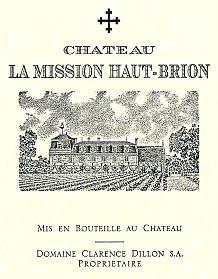 Château La Mission Haut-Brion
Château La Mission Haut-Brion
Tasting Notes: 55% Merlot, 42% Cabernet Sauvignon, and 3% Cabernet Franc. A very tight nose up front, showing nothing but bright red fruits and then opening up to notes of cassis, minerals, mild oak, vanilla cream and raspberry. Silky yet strong tannins in the mouth with great balance, great fruitiness and a full body. There are flavors of blackberries, dark chocolate and leather.
Rating: 15/20 (WS 91)
Price: $102 USD @ Wine Spectator, auction price
2004 Château Haut-Brion
 Tasting Notes: 61% Merlot, 20% Cabernet Sauvignon, and 19% Cabernet Franc. Bright, fresh fruit on the nose, showing nice richness and a subtle elegance. There are notes of black cherry, black berry, and mineral. Creamy, rich, and silky tannins with a fully body and a great acidic balance. Black fruits, plums and cherries dance around the palate.
Tasting Notes: 61% Merlot, 20% Cabernet Sauvignon, and 19% Cabernet Franc. Bright, fresh fruit on the nose, showing nice richness and a subtle elegance. There are notes of black cherry, black berry, and mineral. Creamy, rich, and silky tannins with a fully body and a great acidic balance. Black fruits, plums and cherries dance around the palate.
Rating: 17/20 (WS 95)
Price: $142 USD @ Wine Spectator, auction price
 2004 Château Laville Haut-Brion
2004 Château Laville Haut-Brion
Tasting Notes: 83% Semillon and 17% Sauvignon Blanc. A beautiful citrus and apple punch on the nose, followed by notes of fleshy fruit, melon, and rocks. Medium-bodied with a balanced and mild acidity and a silky, smooth texture. There are flavors of apple and apple skin and a sourness lingering on sides and back of the mid palate.
Rating: 16/20 (WS 93)
Price: $133 USD @ Wine Spectator, auction price
2004 Château Haut-Brion Blanc
Tasting Notes: 51% Sauvignon Blanc and 49% Semillon. Dare I say cat pee? The nose is very complex and inviting, showing white, fleshy fruit, apple, white pepper, piquant, melon, and grass. Citrusy and juicy in the mouth with a great acidic balance, and a velvety, smooth texture. This wine is very refreshing with flavors of orange peel, lemon, and apple.
Rating: 17/20 (WS 94)
Price: $350 USD @ Wine Spectator, release price







